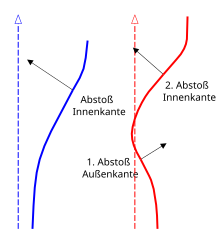Double push technique
The double push technique is a variation of the ice skating step that is mainly used in inline speed skating . At first, the skate is not displayed sideways, as is the case with a normal ice-skating step, but guided under the body to allow an additional imprint on the outer edge before the normal imprint on the inner edge. Chad Hedrick first used this technique in a competition in 1993 and dominated international competitions for several years from 1994. Whether Hedrick invented the technique himself or whether it was previously practiced by Dutch skaters in the rain is a matter of dispute. Today this technique is used in inline speed skating by all top runners.
A successful transfer of this technique to speed skating has not yet been successful. When skating of cross-country skiing the double-push was adapted, the use is due to the high technical requirements but very limited.
Double push when inline skating
The double push in inline skating can be roughly divided into the following phases, which follow one another when looking at one leg:
- Put on the skate
- Imprint on the outer edge ( outpush )
- Shifting the body's center of gravity from the outside inwards
- Imprint of the inner edge ( inpush )
- Taking off the skate
- Active guidance of the lifted skate behind the others in a vertical position (support of the outpush of the opposite side)
The phases of both legs overlap. The other skate is put on while the impression is made over the inner edge. Then the attached skate describes an S-shape. In contrast to the classic technique, the skate describes a small curve inwards. The other skate is lifted off during the following impression over the outer edge. The rolling skate now describes an arc to the outside, where the "normal" imprint is made over the inner edge.
literature
- Barry Publow: Speed on Skates . Human Kinetics, 1998, ISBN 0-88011-721-4
- Michael Nentwig: Double Push or classic technique: Physiological measurements to optimize speed skating techniques . Institute for Sport and Sport Science at the University of Kiel , 2001 ( full text )
